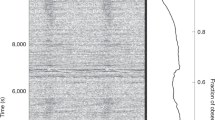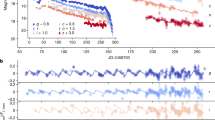Abstract
After previous searches for radio pulsars in globular clusters1,2, a radio pulsar with a period of 3.054 millisecond has now been discovered in NGC6626 (M28)3. The upper limit of 3×10–17 to the observed period derivative indicates that the pulsar is not in a binary3. Millisecond pulsars are probably 'recycled' old pulsars which have been spun-up through accretion from a binary stellar companion4,5. In a globular cluster such a binary is likely to have formed in a tidally dissipative collision between an old neutron star and a low-mass field star from the cluster. Eventually, a mass-transfer phase ensues and the accretion of only ∼0.1M⊙ from the companion is sufficient to spin up the neutron star to millisecond periods. Later in the history of the binary, it can undergo a catastrophic collision with a passing field star from the cluster, the net result of which may be a neutron star with a massive disk orbiting it. After much of the material is expelled via accretion-generated radiation pressure, only an isolated millisecond radio pulsar remains. We also explore the possibility that accretion from a massive disk is able directly to spin up the neutron star; in this case, however, the predicted number of millisecond pulsars in globular clusters would be ten times the number of bright low-mass X-ray binaries. In the model where the neutron star is spun up in a binary the predicted number of millisecond pulsars is significantly smaller. If the millisecond pulsar in NGC6626 has a magnetic moment similar to that of the other three known millisecond pulsars, the epoch of spin-up must have terminated ≲8×108 yr ago.
This is a preview of subscription content, access via your institution
Access options
Subscribe to this journal
Receive 51 print issues and online access
$199.00 per year
only $3.90 per issue
Buy this article
- Purchase on Springer Link
- Instant access to full article PDF
Prices may be subject to local taxes which are calculated during checkout
Similar content being viewed by others
References
Hamilton, T. T., Helfand, D. J. & Becker, R. H. Astr. J. 90, 606–608 (1985).
Mahoney, M. J. & Erickson, W. C. Nature 317, 154–155 (1985).
Lynn, A. G. et al. Nature 328, 399–401 (1987).
Radhakrishnan, V. Contemp. Phys. 23, 207 (1982).
Alpar, M. A., Cheng, A. C., Ruderman, M. A. & Shaham, J. Nature 300, 728–730 (1982).
Katz, J. I. Nature 253, 698–699 (1975).
Van den Heuvel, E. P. J., Van Paradijs, J. & Taam, R. E. Nature 322, 153–155 (1986).
Ruderman, M. A. & Sutherland, P. G. Astrophys. J. 196, 51–72 (1975).
Kulkarni, S. R. Astrophys. J. 306, L85–L89 (1986).
Wright, G. A. & Loh, E. D. Nature 324, 127–128 (1986).
Bhattacharya, D. & Srinivasan, G. Curr. Sci. 55, 327–330 (1986).
Verbunt, F. & Hut, P. in IAU Symp. 125: The Origin and Evolution of Neutron Stars (eds Helfand, D. J. & Huang, J. H.) 187 (Reidel, Dordrecht, 1984).
Fabian, A. C., Pringle, J. E. & Rees, M. J. Mon. Not. R. astr. Soc. 172, pl5–pl8, (1975).
Krolik, J. Astrophys. J. 282, 452–465 (1984).
Verbunt, F. Space Sci. Rev. 32, 379–404 (1982).
Van den Heuvel, E. P. J. J. Astrophy. Astr. 5, 209–233 (1984).
Taam, R. E. & Van den Heuvel, E. P. J. Astrophys. J. 305, 235–245 (1986).
Hut, P. & Paczyríski, B. Astrophys. J. 284, 675–684 (1984).
Bonsema, P. F. J. & Van den Heuvel, E. P. J. Astr. Astrophys. 146, L3–L5 (1985).
Hills, J. G. Mon. Not. R. astr. Soc. 175, p1–p4 (1976).
Krolik, J., Meiksin, A. & Joss, P. C. Astrophys. J. 282, 466–480 (1984).
McMillan, S. L. W. Astrophys. J. 306, 552–564 (1986).
Sutantyo, W. Astr. Astrophys. 44, 227–230 (1975).
Verbunt, F. Astrophys. J. 312, L23–L25 (1987).
Webbink, R. F., Rappaport, S. A. & Savonije, G. J. Astrophys. J. 270, 678–693 (1983).
Taam, R. E. Astrophys. J. 270, 694–699 (1983).
Joss, P. C. & Rappaport, S. A. Nature 304, 419–421 (1986).
Paczyński, B. Nature 304, 421–422 (1986).
Savonije, G. J. Nature 304, 422–423 (1986).
Helfand, D. J., Ruderman, M. A. & Shaham, J. Nature 304, 423–425 (1986).
Hut, P. & Bahcall, J. N. Astrophys. J. 268, 319–340 (1983).
Author information
Authors and Affiliations
Rights and permissions
About this article
Cite this article
Verbunt, F., van den Heuvel, E., van Paradijs, J. et al. Formation of isolated millisecond pulsars in globular clusters. Nature 329, 312–314 (1987). https://doi.org/10.1038/329312a0
Received:
Accepted:
Issue Date:
DOI: https://doi.org/10.1038/329312a0
This article is cited by
-
Newly Born Extragalactic Millisecond Pulsars as Efficient Emitters of PeV Neutrinos
Brazilian Journal of Physics (2021)
-
Discovery of two radio pulsars in the globular cluster M15
Nature (1990)
-
A 5.75-millisecond pulsar in the globular cluster 47 Tucanae
Nature (1990)
-
Black holes in cosmic bodies
Astrophysics and Space Science (1990)
Comments
By submitting a comment you agree to abide by our Terms and Community Guidelines. If you find something abusive or that does not comply with our terms or guidelines please flag it as inappropriate.



